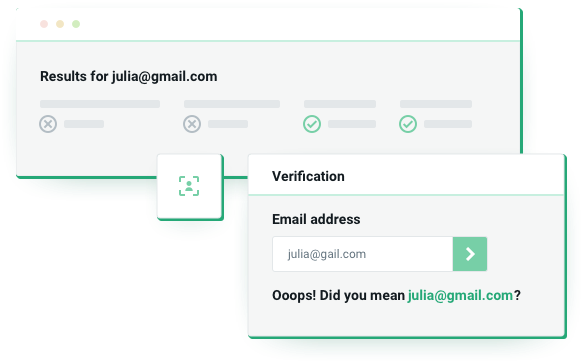Deliverability
Spam traps: How to find them and keep them off your list
Not all spam traps are created equal, which means that the consequences you face will vary in kind depending on the type of trap.
PUBLISHED ON
There are different types of traps for different creatures. Rat traps for rodents, bear traps for grizzlies, and spam traps for – you guessed it – spammers.
Of course, an unsuspecting hiker might step into a bear trap if he goes too far off the trail. And if email senders are treading where they shouldn’t be, spam traps could become a problem too. We’re talking about some serious setbacks to your email deliverability.
Admiral Ackbar of Star Wars fame is not going to be around to yell “It’s a trap!” So, what can you do to spot spam traps and avoid them in the first place?
Table of content
1. Pristine spam traps or honeypots
2. Recycled spam traps
3. Typo spam traps
Email verification vs validation
What are spam traps?
For starters, let’s make sure this is clear: Spam traps are meant to catch spammers, not spammy messages. Mailbox providers use spam filters to determine which messages should get sent to the junk folder. Spam traps help mailbox providers and email blocklist owners identify which senders are being spammy.
A spam trap is actually just an email address. However, there is no real person behind the email address. Spam traps are either fake contacts or email addresses that have been abandoned and are no longer in use. Send a campaign to one of these addresses, and it’s a pretty good sign that you’re up to no good. Just a single email to the wrong address can damage your sender reputation or even get all your emails blocked.
Three types of spam traps
Let’s take a closer look at how the three different kinds of spam traps are classified.
Pristine spam traps/honeypots
Recycled spam traps
Typo spam traps
Not all spam traps are created equal, and neither are the potential consequences for getting caught with them on your list. In fact, there’s only one type that can get you in big trouble with anti-spam organizations in a big hurry. That’s the type of spam trap that tops our list.
1. Pristine spam traps or honeypots
Honeypots are irresistible to certain wild animals. In the same way, a honeypot spam trap is deeply alluring to an email scammer or spammer. It’s a nice succulent email address just waiting to receive some unsolicited mail. But that honeypot is nothing but a decoy.
More commonly referred to as true or pristine spam traps, these are “fake” email addresses that blocklists and inbox service providers create and then place around the web. Pristine spam traps also show up on purchased email lists. That’s because the people selling email contacts aren’t the most trustworthy people around either.
When spammers buy a collection of email addresses or scrape the web to collect contacts, one (or more) of these pristine spam trap email addresses may end up on their list. Since there are no real subscribers connected to these email addresses, the presence of a pristine spam trap on your list tells mailbox providers that you are probably a spammer.
If there’s a pristine spam trap on your list, it’s highly unlikely that it got there because someone used it to opt in to your emails or subscribe to your list. In fact, it's pretty close to impossible.
Attempting to send emails to a pristine spam trap is the quickest way to get labeled as a spammer and get your email messages blocked from being delivered to the inbox.
2. Recycled spam traps
A recycled spam trap can be a little harder to identify and a little less likely to get you in trouble. But they can still be a problem. Here’s a common scenario that can lead to a recycled spam trap ending up on your email list:
Suppose you have a subscriber who uses their work email address to opt in to your list. This happens all the time. But what happens when that person leaves that job? Their email address becomes obsolete, but it still exists on email lists. At one time, it was a real email address, but now it’s unused. The same thing can happen with college email addresses after students graduate.
Mailbox providers pick up on this when messages start bouncing back from invalid email addresses. And in some such cases, they’ll start using the obsolete email address as a spam trap. Thus, what once may have been an actively engaged subscriber has become an email reputation shredder.
Purchased email lists are also quite likely to contain old, invalid email addresses that are no longer in use. So, while recycled traps aren’t quite as clear a sign of a spammer as pristine traps, they can cause mailbox providers to take notice and get suspicious.
Before an address becomes a recycled spam trap, it will show up as a hard bounce in your email analytics. Once it turns into a trap, it won’t bounce anymore. If you send to one of these spam trap email addresses, it means you’re not proactively managing your contacts. And a lack of list hygiene could mean damage to your email sender reputation.
3. Typo spam traps
Typo spam traps are the most innocent of the three, but also the most frustrating. We first caught on that Spamhaus was using them back in 2014. Sometimes, real people subscribe to your email list or handwrite an email address on a form at an event, but it doesn’t get typed correctly or is hard to read.
Common email typos include using .con instead of .com, or gnail instead of gmail. The letter “N” is right next to “M” on the keyword, and the words look similar enough that sometimes people don’t realize their mistake.
This doesn’t necessarily indicate you’re a spammer, but it represents shortcuts and sloppiness that mailbox providers don’t like to see from legitimate senders. It’s also a clue that the sender is not using a double opt-in process to confirm that subscribers really want to be added to a list. This suggests some shady list-building practices might be taking place.

What happens if you send to a spam trap?
The consequences of sending emails to spam traps vary depending on the type.
As mentioned earlier, pristine spam traps have the most immediate repercussions, because these were never legitimate email addresses, and the mailbox provider or blocklist knows it.
Once an email gets sent to a honeypot, the sender may be put straight on a blocklist, meaning future emails sent from that address (or even the entire IP address or organization) won’t be delivered.
With recycled and typo spam traps, it takes a bit more time to make a determination on the nature of the sender, so penalties don’t happen immediately. But it definitely doesn’t help a sender’s reputation. If that reputation is already on shaky ground or the sender repeatedly mails to these addresses, their email deliverability could dip or they could end up blocked.
What is poor deliverability? It can mean your emails are sent to the spam folder. It can also mean that they’re never delivered at all. This happens when the sender is on a blocklist.
How to find and avoid spam traps
Avoiding pristine spam traps is easy. Don’t purchase email lists, and don’t hire anyone to use software that scrapes websites for email addresses. Refrain from those two activities, and you shouldn’t have to worry about honeypots.
For the other two types, you need to identify the spam traps before you can purge them from your list. That’s what it takes to keep your email list clean. You have to go into your email list, study your deliverability reports, look at your bounces, and delete the outdated email addresses and contacts with typos in them.
You can look for typos and try to update them manually. And you can watch for hard bounces and remove those contacts from your list. But you can also automate this process so there's one less thing to worry about. if your list is really in need of a good scrubbing, there are tools that can help you get the job done.
Email verifications from Mailgun Optimize are the perfect example. You can use this feature to upload your entire list for bulk verifications. This process will help you weed out all the invalid and outdated emails.
Plus, with the real-time email verification API from Mailgun Optimize you can validate contacts at the point of collection. That means you can catch those typos before an incorrect email address gets added to your list.
Email verification vs validation
Email verification and validation are close cousins, but one does a bit more than the other.
Email validation ensures all of your email addresses are properly formatted. Validation will catch most typo errors and other mistakes. Email verification takes on the much more formidable challenge of ensuring that an actual person is behind each email address.

You can use email verification to clean a list one time, or you can use it on an ongoing basis, including with your email signup forms. Either way, it’s a major timesaver, and it ensures more human mistakes won’t corrupt your list.
Cleaning your list once makes sense when you’ve just inherited a new list or have a bunch of email addresses you just aren’t sure about, and they keep showing up on your bounce reports.
Another best practice for avoiding spam traps is to use a suppression list. That’s just a collection of contacts you want to make sure will stay off any list your brand creates. A suppression list contains addresses you do not want to send to. It could include hard bounces, people who’ve unsubscribed, and people who make spam complaints.
The importance of email list cleaning
All of this probably makes sense so far. Spam traps catch the bad guys. Don’t do what they do. Avoid purchased email lists like the plague. Then be sure to maintain your legitimate email list, and you should be good to go, right?
Well, maybe. But think about the scope of the problem. Keeping your list clean is an ongoing issue. People will always make typos and switch to different email addresses. List cleaning isn't a one-and-done task. It needs to be done regularly.
The larger your email lists, the more daunting the task becomes. Who wants to spend hours and hours scouring hundreds of email addresses at a time?
This is even more daunting if you’re in a situation where you just got the job and have inherited a mess of an email list. You don’t know where these email addresses came from, but the bounce rate is high, engagement is low (perhaps because poor deliverability means you’re not making it to the inbox), and you don’t want to make it worse. Automation is the answer.
Using email verification on an ongoing basis is the best approach, because it will evaluate every single new email address that is added to your list. Some companies have new subscribers added from all over the place. An event here, a marketing campaign there, a referral from a joint venture partnership here, an intern working too hard there, and bazoom – you’ve got tons of new unverified email addresses to deal with.
Email verification makes sure that ALL new email addresses are real. And, it will catch existing ones when they turn obsolete so you avoid sending emails to a potential recycled spam trap.
Popular posts

Here’s everything you need to know about DNS blocklists
The word “blocklist” can almost seem like something out of a movie – a little dramatic, silly, and a little unreal. Unfortunately, in the real world, blocklists are definitely something you...
Read more


